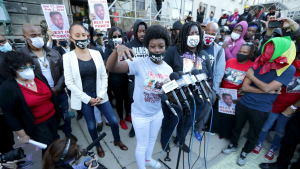The dark history of Native American boarding schools.
By Christina Callicott
“Only by complete isolation of the Indian child from his savage antecedents can he be satisfactorily educated.” When John B. Riley, Superintendent of Indian Schools, wrote those words in his 1886 report to the U.S. Department of the Interior, he expressed a sentiment, and gave voice to a strategy, that was gaining traction across the nation: That the least expensive way to put an end to the “Indian problem” was, rather than maintain a standing army for the purposes of extermination, to assimilate them into white, Christian society—and that the best way to do that was to remove Native American children from their families and their communities; strip them of their cultures, their languages, their clothes and their hair; and turn them into industrious members of the capitalist society that they were thereafter intended to serve.
By the turn of the century, the federal government had built over two dozen off-reservation, government-run boarding schools for Native American children, including the Teller Institute in Grand Junction and the Fort Lewis Indian School in Hesperus, just outside Durango. The Teller Institute was converted into a mental health care center in the early twentieth century, but the Fort Lewis Indian School eventually became what we know today as Fort Lewis College. These schools were part of a system of residential and day schools that numbered in the hundreds and stretched across the U.S. and Canada. With the recent discovery of unmarked children’s graves at Canada’s Kamloops Indian Residential School, and the subsequent announcement by Secretary of the Interior Deb Haaland of a comprehensive review of U.S. Indian boarding schools, the nation’s eyes have turned toward Fort Lewis College, whose dark history persists in the form of a tuition waiver for all qualified Native American and Alaska Native students.
While the waiver has led to one of the highest rates of Indigenous student attendance in the nation—their student body boasts over 40 percent Indigenous students—the misperception that they go to school for free perturbs Indigenous students at Fort Lewis. In fact, the waiver doesn’t cover student fees, books, or room and board—costs that are significant for any student but that can be especially burdensome for those coming from an economically disadvantaged background. Add in the social, cultural, and logistical challenges that students can face coming from a reservation or first-generation background, and it’s clear that free tuition is a far cry from a free education.
For Indigenous students, however, the problem cuts closer to the bone. From 1892-1911, Fort Lewis Indian School housed anywhere from a few dozen to almost 250 students, mostly from the Dineh (Navajo), Apache, Ute, and Hopi nations. They passed their days in the highly regimented, severely disciplined, militaristic fashion devised by Richard Henry Pratt. Founder of the first Indian boarding school, Carlisle Industrial Indian School, Pratt’s methods derived from his years supervising Indian prisoners of war. He is most famous for the quote that summed up his strategy: “Kill the Indian, save the man.”
Research into living conditions and student experiences at Fort Lewis has just begun, so the extent of the trauma that its residents endured is not yet known. However, the broader story of U.S. Indian boarding schools is well known. Children were often rounded up en masse and loaded onto trains to be shipped to schools far away. Native American families use the term “kidnapped.” Thomas Jefferson Morgan, Commissioner of Indian Affairs, was explicit about the use of force to remove children from their families. “We owe it to these children to prevent, forcibly if need be, so great and appalling a calamity from befalling them,” he wrote in 1891. So that they would not grow up to become “a race of barbarians and semi-savages.” The fact that many families never saw their children again was not a failure of the system but a product of its design.
Having arrived at a boarding school, children’s hair was cut, an act of mourning for many tribes. They were often doused in kerosene or dusted with DDT. Their traditional garments were burned or disposed of and exchanged for Western-style clothing according to dominant gender norms. They were often issued new names. Given that the overarching goal of the schools was not education but assimilation, Indigenous languages were forbidden, and children were routinely beaten for speaking their native tongue. Traditional spiritual practices were banned, and attendance at Christian church services was compulsory. What education did exist was oriented toward menial labor. Many Native Americans see a direct connection between the end of African-American slavery and the rise of Indian Industrial Schools, whose roots lay in President Ulysses S. Grant’s Peace Policy of 1869.
Violence and abuse of all forms was rampant in the schools, both between staff and students as well as among students themselves. Studies estimate that during the height of the boarding school era in the late 1920s, between 40 and 80 percent of all school-age Native American children were in some kind of federally sponsored school. To many Native Americans, that represents a lost generation—and a collective experience with repercussions that are still felt today.
Cultural psychologist Tommy Begay, a Dineh man and a researcher with the University of Arizona College of Medicine, studies the physiological, neurological, and cultural mechanisms by which historical trauma is passed down through generations. “When you go to these border towns like Gallup or Farmington and you see these Indigenous people in the streets you think, ‘What’s wrong with these people? They can’t handle their alcohol,’” said. “But what you don’t see is the pain, the fear, the shame.”
He sees behaviors such as drug and alcohol use, and even sex addiction and suicidal behavior and ideology, as forms of self-medication with their roots in historical trauma. He uses the term “cultural augmentation” to refer to maladaptive behaviors that become part of the culture as a result of historical trauma. “When I speak in public at a conference or something,” Begay said, “often these older Native American men will come up to me afterward and very discreetly say, ‘I understand now why I acted the way I did when I was younger, why I treated people so badly. I never understood before.’”
Begay’s own parents are survivors of boarding schools, and he acknowledges that that history, and his own struggles with addiction, led him to the line of research that he pursues today. However, his great-grandmother was a medicine woman, and to her teachings, he attributes his resiliency, as well as his professional focus on ceremonial healing practices. “From the Indigenous perspective,” he said, “we have this relationship with the earth and with the universe. That’s really what brings us a sense of balance. My great-grandmother, a Navajo medicine woman, used to refer to that as living in harmony; she called it ‘the natural order.’ What we see today is a culture disconnected from healing, from ceremony, from language.”
It is to these losses that Ally Gee refers when she rejects the idea of Fort Lewis’s tuition waiver as a form of reparations. “I just don’t think the tuition waiver is enough in terms of all the harm that was done and all the culture and language that was lost,” said Gee, a Dineh woman and FLC graduate. Majel Boxer, Sisseton and Wahpeton Dakota and professor of Native American and Indigenous Studies at FLC, is adamant that the waiver was not intended, nor should it be considered, as a form of reparations: “It is a contractual obligation that the state agreed to when it accepted the transfer of land and buildings from the federal government,” she asserted.
Others see it as an aspect of the government’s treaty obligations toward Indian nations. For FLC graduate and chemistry professor Joslynn Lee, the waiver represents payment for the land on which the original school sat: “Being from the area,” she said, “I know what land was given up, and what the resources are, the minerals and water and land that have accumulated money for the state and private companies.”
Lee, a Dineh and Pueblo woman, has three grandparents who went to boarding school. It was her decision in 2019 to speak out against the misrepresentation of FLC’s history that sparked the school’s current move toward reconciliation. Thus far the process has culminated in the ceremonial removal of a set of panels prominently displayed on the college’s clock tower that inaccurately portrayed boarding school reality. Now, with Secretary Haaland’s Federal Indian Boarding School Initiative, FLC has begun consultation with tribes regarding if and how they should proceed with the search for graves on the old Fort Lewis campus. The decision is up to the tribes, some of whom have prohibitions against disturbing the dead.
For Ally Gee, while the losses were significant, Indigenous resilience represents a major victory. “I think about how amazing it is for Native students and other students of color to be able to occupy this colonial space that wasn’t really made for us,” she said. “It’s hard to think about how our ancestors were treated in these schools, and how much harm had to be done in order for us to be where we are now. But it’s such a win for students in academia that we can indigenize these colonial spaces, and that we can learn to be good teachers or lawyers or whatever to help further tribal sovereignty.” She finds it empowering that despite all the attempts to kill their culture, her grandparents and parents were able to retain fluency in their language.
For Tommy Begay, language is key to healing. “When we talk about connecting with our spirituality, it’s through the language,” he said. “We need peace, we need calm, we need ceremony. You can look at the deficits and trauma, but the flip side of that is the sacredness of life, the sacredness of love, and how love can be used as a healing mechanism. That’s the natural order that my great grandmother taught me.”




